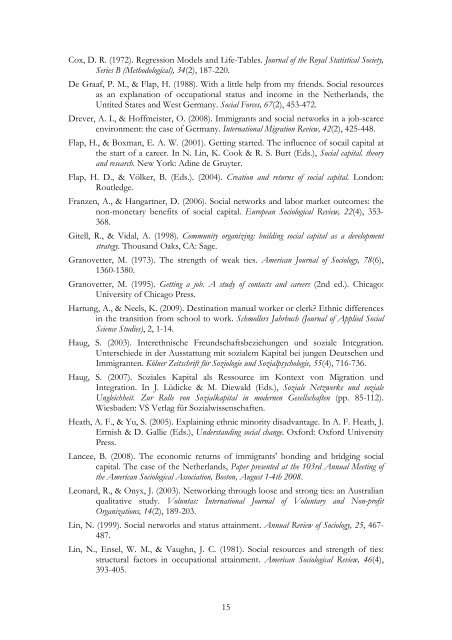Turkish migrants and native Germans compared - IMISCOE Cross ...
Turkish migrants and native Germans compared - IMISCOE Cross ...
Turkish migrants and native Germans compared - IMISCOE Cross ...
You also want an ePaper? Increase the reach of your titles
YUMPU automatically turns print PDFs into web optimized ePapers that Google loves.
Cox, D. R. (1972). Regression Models <strong>and</strong> Life-Tables. Journal of the Royal Statistical Society,Series B (Methodological), 34(2), 187-220.De Graaf, P. M., & Flap, H. (1988). With a little help from my friends. Social resourcesas an explanation of occupational status <strong>and</strong> income in the Netherl<strong>and</strong>s, theUntited States <strong>and</strong> West Germany. Social Forces, 67(2), 453-472.Drever, A. I., & Hoffmeister, O. (2008). Im<strong>migrants</strong> <strong>and</strong> social networks in a job-scarceenvironment: the case of Germany. International Migration Review, 42(2), 425-448.Flap, H., & Boxman, E. A. W. (2001). Getting started. The influence of socail capital atthe start of a career. In N. Lin, K. Cook & R. S. Burt (Eds.), Social capital. theory<strong>and</strong> research. New York: Adine de Gruyter.Flap, H. D., & Völker, B. (Eds.). (2004). Creation <strong>and</strong> returns of social capital. London:Routledge.Franzen, A., & Hangartner, D. (2006). Social networks <strong>and</strong> labor market outcomes: thenon-monetary benefits of social capital. European Sociological Review, 22(4), 353-368.Gitell, R., & Vidal, A. (1998). Community organizing: building social capital as a developmentstrategy. Thous<strong>and</strong> Oaks, CA: Sage.Granovetter, M. (1973). The strength of weak ties. American Journal of Sociology, 78(6),1360-1380.Granovetter, M. (1995). Getting a job. A study of contacts <strong>and</strong> careers (2nd ed.). Chicago:University of Chicago Press.Hartung, A., & Neels, K. (2009). Destination manual worker or clerk? Ethnic differencesin the transition from school to work. Schmollers Jahrbuch (Journal of Applied SocialScience Studies), 2, 1-14.Haug, S. (2003). Interethnische Freundschaftsbeziehungen und soziale Integration.Unterschiede in der Ausstattung mit sozialem Kapital bei jungen Deutschen undImmigranten. Kölner Zeitschrift für Soziologie und Sozialpsychologie, 55(4), 716-736.Haug, S. (2007). Soziales Kapital als Ressource im Kontext von Migration undIntegration. In J. Lüdicke & M. Diewald (Eds.), Soziale Netzwerke und sozialeUngleichheit. Zur Rolle von Sozialkapital in modernen Gesellschaften (pp. 85-112).Wiesbaden: VS Verlag für Sozialwissenschaften.Heath, A. F., & Yu, S. (2005). Explaining ethnic minority disadvantage. In A. F. Heath, J.Ermish & D. Gallie (Eds.), Underst<strong>and</strong>ing social change. Oxford: Oxford UniversityPress.Lancee, B. (2008). The economic returns of im<strong>migrants</strong>' bonding <strong>and</strong> bridging socialcapital. The case of the Netherl<strong>and</strong>s, Paper presented at the 103rd Annual Meeting ofthe American Sociological Association, Boston, August 1-4th 2008.Leonard, R., & Onyx, J. (2003). Networking through loose <strong>and</strong> strong ties: an Australianqualitative study. Voluntas: International Journal of Voluntary <strong>and</strong> Non-profitOrganizations, 14(2), 189-203.Lin, N. (1999). Social networks <strong>and</strong> status attainment. Annual Review of Sociology, 25, 467-487.Lin, N., Ensel, W. M., & Vaughn, J. C. (1981). Social resources <strong>and</strong> strength of ties:structural factors in occupational attainment. American Sociological Review, 46(4),393-405.15


